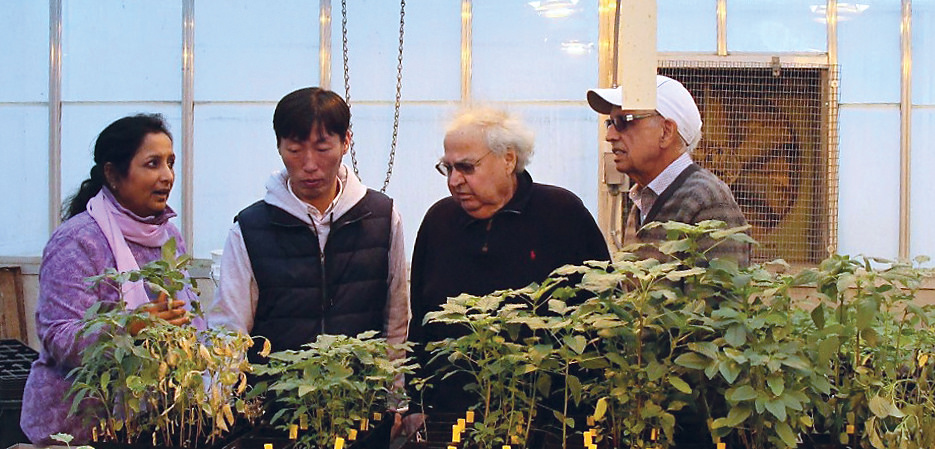
Kansas State University researchers have discovered the mechanism by which weeds develop resistance to glyphosate, an herbicide. Their work could lead to improved weed control strategies and improved production in farm fields and other areas where weeds affect plants and crops. Pictured, left to right, are Mithila Jugulam, Dal-Hoe Koo, Bernd Friebe and Bikram Gill. | Download this photo.
Kansas State University researchers make breakthrough toward understanding glyphosate resistance in pigweeds
Findings have implications for agriculture, other industries
March 12, 2018
MANHATTAN, Kan. – Kansas State University researchers have discovered how weeds develop resistance to the popular herbicide glyphosate, a finding that could have broad future implications in agriculture and many other industries.
Their work is detailed in an article that appears in the March 12 edition of the Proceedings of the National Academy of Sciences, known as PNAS and considered to be one of the most-cited journals for scientific research in the world. According to its website, PNAS receives more than 21 million hits per month.
“Herbicide resistance in weeds has been a huge problem, not only in Kansas and the U.S. but many parts of the world,” said Mithila Jugulam, a K-State weed scientist and co-author of the PNAS article.
“What we found that was new was how these weeds have evolved resistance to glyphosate in such a short time. If you look at the evolution of glyphosate resistance in Palmer amaranth, based on our research, it appears to have occurred very rapidly.”
Palmer amaranth and common waterhemp are the two troublesome pigweeds in Kansas agricultural fields, as well as other parts of the United States. Glyphosate – the key ingredient in the popular Roundup brand – is the herbicide that is widely used for controlling many weeds. But Jugulam notes that glyphosate resistance is becoming more prevalent in many states.
“We found that glyphosate-resistant Palmer amaranth plants carry the glyphosate target gene in hundreds of copies,” Jugulam said. “Therefore, even if you applied an amount much higher than the recommended dose of glyphosate, the plants would not be killed.”
Bikram Gill, director of Kansas State University’s Wheat Genetics Resource Center who has worked in plant genetics for nearly 50 years, said the researchers knew pretty quickly that the genetic makeup of resistant weeds was different.
“Normally, the genetic material in all organisms – including humans – is found in long, linear DNA molecules, called chromosomes,” said Gill, another co-author of the study. “But when (K-State researchers) Dal-Hoe Koo and Bernd Friebe, the chromosome experts on the team, looked at these glyphosate-resistant weeds, the glyphosate target gene, along with other genes actually escaped from the chromosomes and formed a separate, self-replicating circular DNA structure.”
Click play to listen to an interview with K-State's scientists talking about this breakthrough
Scientists refer to this structure as extra-chromosomal circular DNA (eccDNA). Each eccDNA has one copy of the gene that produces an enzyme that is the target for glyphosate.
“Because of the presence of hundreds of eccDNAs in each cell, the amount of the enzyme is also abundant,” Gill said. “Therefore, the plant is not affected by glyphosate application and the weed is resistant to the herbicide.”
Gill said the indications are that once a weed has acquired eccDNA, the resistance may evolve as quickly as in one generation.
“We think that the resistance via eccDNA is transitory: It can be passed to the weed’s offspring and other related weed species,” he said. “We have somehow caught it in between becoming permanently resistant. Eventually, we think that these eccDNAs can be incorporated into the linear chromosome. If that happens, then they will become resistant forever.”
The same K-State group recently published research on common waterhemp in the scientific journal, Plant Physiology, reporting that “a portion of the linear chromosome containing the target gene broke to form a ring chromosome carrying several copies of the glyphosate target gene,” according to Jugulam.
Armed with their new knowledge, the researchers can begin work on developing strategies to negate resistance in weeds.
“It’s been known that these circular DNA/chromosomal structures can be unstable,” Jugulam said. “What we want to explore is, for example, if we do not apply glyphosate repeatedly or reduce the selection by glyphosate, can we make these ring-structured chromosomes unstable and once again make these plants susceptible to glyphosate.”
The research team notes that farmers should incorporate best management strategies – such as rotating herbicides and crops – to reduce weed pressure: “This may allow evolving resistance to dissipate as we know that these eccDNAs and ring chromosomes are unstable and can be lost in the absence of herbicide selection pressure,” Jugulam said.
“Glyphosate has a lot of good characteristics as an herbicide molecule,” she added. “The recommendations that K-State and many others are promoting is ‘do not abuse glyphosate.’ Use the recommended integrated weed management strategies so that we do not lose the option of using glyphosate for the sustainability of our agriculture.”
Funding for this research was provided in part by grants from the Kansas Wheat Commission; the Kansas Crop Improvement Association; a National Science Foundation grant received through the Wheat Genetics Resource Center; the K-State Department of Agronomy (College of Agriculture); and USDA’s Agricultural Research Service. Kansas State University worked in collaboration with researchers at Clemson University, the USDA Agricultural Research Service (Mississippi) and Michigan State University.
The full article can be accessed on the website for the Proceedings of the National Academy of Sciences.

